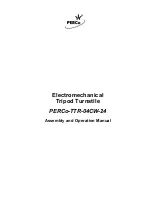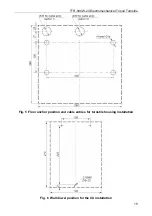
Assembly and Operation Manual
10
The arm rotation sensors, placed inside the turnstile housing, track passages through the
turnstile. A passage direction is determined according to sequence of sensors actuation.
The signals are generated at the contacts
“Sens R/Pass R
”
and
“Sens L/Pass L
”
of the
CU
“ACS
”
connector at each passage when turning the barrier arms. The signal duration
depends on the rotation speed of the barrier arms.
There can be 2 variants of signals generation:
Variant 1: The high-level signal is transmitted to the
“
Sens R/Pass R” contacts at
passage in one direction (the signal begins at the moment arms are turned 67° and
ends at the moment the arms are back in their home position), and to the
“Sens
L/Pass L
”
– at passage in the opposite direction.
Variant 2: Information on state of rotation sensors is transmitted to the
“Sens
R/Pass R
”
and
“Sens L/Pass L
”
contacts. At passage, turning the hub (11 in Fig.1)
at 120°, the following pattern is formed:
turning at approximately 8° – a high-level signal at
“Sens R/Pass R
”
(the
transistor is closed);
turning at approximately 53° – a high-level signal at
“Sens L/Pass L
”
(the
transistor is closed);
turning at approximately 67° – a low-level signal at
“Sens R/Pass R
”
(the
transistor is open);
turning at approximately 112° – a low-level signal at
“Sens L/Pass L
”
(the
transistor is open).
The pattern at the
“Sens R/Pass R
”
and
“Sens L/Pass L
”
contacts is changed at passage
in the opposite direction.
NOTE!
The variant of signal generation is set by the jumper on the J3 connector (for the J3
connector location see label inside the control unit): the jumper is not installed —
variant 1, the jumper is installed — variant 2. At delivery the jumper is not installed.
The jumper is supplied with a set of spare parts.
The CU output cascades are the circuit with open collector output with the following signal
characteristics:
the maximum voltage ...................................................................... no more than 25 V
the maximum current.................................................................... no more than 50 mA
In the initial position the transistors are open (a low-level signal).
There are several additional signals put out at the CU “ACS” connector:
“
Pwr failure”
– AC mains failure (the open collector, an active high-level signal);
“
Pass Sensor”
– state of additional infrared sensor of an intrusion detector, if
applied (the open collector, an active high-level signal);
“
Bat failure”
– the SPS failure (the open collector, an active high-level signal);
“
Plug-in”
– the signal informing ACS that the system connector is switched on
(a low-level signal);
“
Auto/SYS”
– the signal level of this contact determines the way of setting
the passage waiting time (the signal data is the same as for the
“RIGHT
”
,
“STOP
”
and
“LEFT
”
contacts):
when
the
“Auto/SYS
”
contact is not connected — the passage waiting time
is equal to 5 seconds (it is determined by the CU internal program setting);
when the low-level voltage is supplied to the contact — the passage waiting
time is infinite. The turnstile will lock either by a
“STOP
”
signal from an ACS
Summary of Contents for TTR-04CW-24
Page 1: ......
Page 2: ...Electromechanical Tripod Turnstile PERCo TTR 04CW 24 Assembly and Operation Manual...
Page 24: ......
Page 26: ...www perco com export perco ru...



























